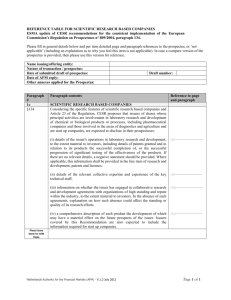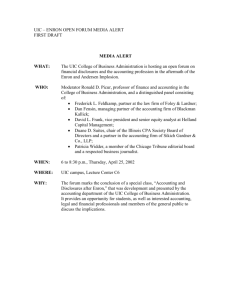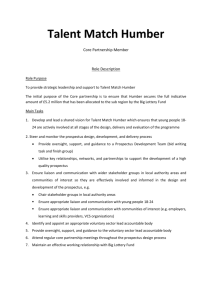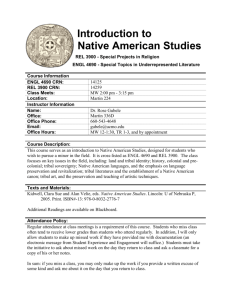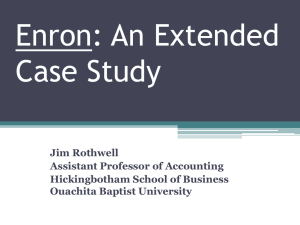Syllabus ()
advertisement
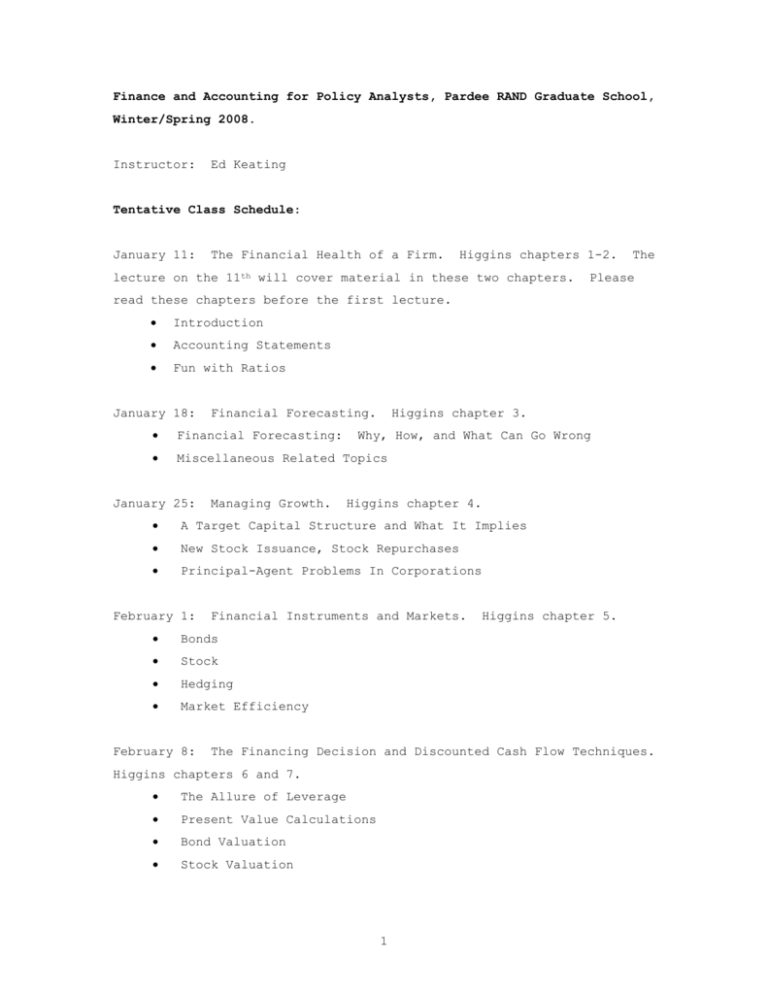
Finance and Accounting for Policy Analysts, Pardee RAND Graduate School, Winter/Spring 2008. Instructor: Ed Keating Tentative Class Schedule: January 11: The Financial Health of a Firm. Higgins chapters 1-2. lecture on the 11th will cover material in these two chapters. The Please read these chapters before the first lecture. Introduction Accounting Statements Fun with Ratios January 18: Financial Forecasting. Higgins chapter 3. Financial Forecasting: Miscellaneous Related Topics January 25: Managing Growth. Why, How, and What Can Go Wrong Higgins chapter 4. A Target Capital Structure and What It Implies New Stock Issuance, Stock Repurchases Principal-Agent Problems In Corporations February 1: Financial Instruments and Markets. Bonds Stock Hedging Market Efficiency February 8: Higgins chapter 5. The Financing Decision and Discounted Cash Flow Techniques. Higgins chapters 6 and 7. The Allure of Leverage Present Value Calculations Bond Valuation Stock Valuation 1 February 15: Midterm. Closed-book, closed-note. Financial or other calculator OK; computer not OK. February 22: Techniques. Go over midterm and more on Discounted Cash Flow More from Higgins chapter 7. NPV’s Tempting Cousin, IRR Assorted Insights on Capital Budgeting February 29: Risk Analysis in Investment Decisions. The Inevitability of Risk The Capital Asset Pricing Model Weighted Average Cost of Capital March 7: Higgins chapter 8. Business Valuation and Corporate Restructuring. Higgins chapter 9 plus the following press articles on Google: Knight, J. “Google Not the First to Go Dutch” The Washington Post p. E1. August 23,2004. Dunbar, C. “Google’s Bad Bid”. National Post’s Financial Post & FP Investing (Canada), p.FP15. August 25, 2004. Nocera, J. “Open and Fair: York Times, p.C1. Why Wall Street Hates Auctions”. New March 18,2006. White, B. “Aiming to Auction Its Way to a More ‘Inclusive’ IPO; Complex Scheme Could Confuse Small Investors”. Washington Post, p.E1. April 30,2004. Miscellaneous Thoughts on Corporate Takeovers Google Goes Dutch March 14: Current Topics of Interest. Read the five Enron articles, three SOX articles, plus Wikipedia article on Enron scandal: http://en.wikipedia.org/wiki/Enron_scandal. Enron Sarbanes-Oxley Five Years Under the Thumb” Prospectus due. The Economist July 26th, 2007. http://www.economist.com/displaystory.cfm?story_id=9545905. 2 Speech by SEC Chairman: Remarks to the National Press Club by Chairman William H. Donaldson. July 30, 2003. http://www.sec.gov/news/speech/spch073003whd.htm. Alles, Michael, Alexander Kogan and Miklos Vasarhelyi (2004). “The Law of Unintended Consequences?: Assessing the Costs, Benefits and Outcomes of the Sarbanes-Oxley Act”. Information Systems Control Journal, Vol 1, 2004. Eichenwald, K. “Enron’s Many Strands: Overview.” Times. The New York P. A1 October 3, 2002. Eichenwald, K. “Ex-Chief Financial Officer of Enron and Wife Plead Guilty.” The New York Times. P. C9 January 15, 2004. Lane, C. “Justices Overturn Andersen Conviction; Advice to Enron Jury on Accountants’ Intent is Faulted”. Washington Post. P.A1. June 1, 2005. Barrionuevo, A. “In Opening Arguments, an Enron Undone by Lies, or Panic”. The New York Times. P. C1. February 1, 2006. March 21: Final. Closed-book, closed-note. Financial or other calculator OK; computer not OK. Text: The textbook is Robert C. Higgins’ Analysis For Financial Management, 8th edition. ground. the book. You’ll note that we’re covering a lot of There is no way class lectures will cover everything done in However, you’re responsible for everything covered in assigned chapters of the textbook. I reserve and am likely to exercise the right to use questions directly from the textbook and/or to use material discussed in the textbook, but not in class. 3 Articles: You’ll note the March 7 lecture asks you to read five press articles on “Google articles” while for March 14 you are to read the five “Enron articles” and three “SOX articles.” You are also to read Wikipedia’s summary of the Enron scandal (http://en.wikipedia.org/wiki/Enron_scandal) for the March 14 lecture. Prospectus: You’ll note you must turn in a “Prospectus” on March 14. The prospectus is a paper each of you will write on your own discussing a potential investment device an individual might utilize. Examples of such devices would include corporate bonds, indexed stock funds, hedge funds, emerging markets funds, real estate investment trusts, variable annuities, Treasury bills, options contracts, commodities futures, term life insurance, and whole life insurance. Don’t feel constrained by this list. (There are many others, too: I wouldn’t, however, recommend you choose an extremely broad category, e.g., “Mutual funds”. helpful.) More focus is I do not want you to write about a specific name brand product, e.g., the Fidelity Magellan fund. Instead, I want you to write about a type of investment. Your assignment is to write a minimum 10-page paper about one of these devices. Your paper must be written so as to be readable and comprehensible to a lay audience, e.g., pretend your parents or spouse (assuming he/she/they aren’t investment bankers) are to read your prospectus. Your prospectus must note the following: the advantages of the product, possible disadvantages, risks of the product, historical returns of the product, costs associated with owning the product, and also some notion of for which types of investors such a product would be appropriate and for which it would be inappropriate. You must cite at least three articles from The Wall Street Journal, you must cite at least three non-newspaper articles (not counting web sites), and you must cite at least three academic journal articles. Your prospectus will be evaluated based on its accuracy, breadth, clarity, completeness, and how informative and well-written it is. I would also suggest your prospectus will benefit from bringing in as much 4 supporting data as possible. on your prospectus. Grades: You may not work in tandem with colleagues Your prospectus will count for 30% of your grade. You will be graded based on your midterm (30%), prospectus (30%), and final (40%). The final is cumulative, but will purposely over-emphasis material covered subsequent to the midterm. 5



